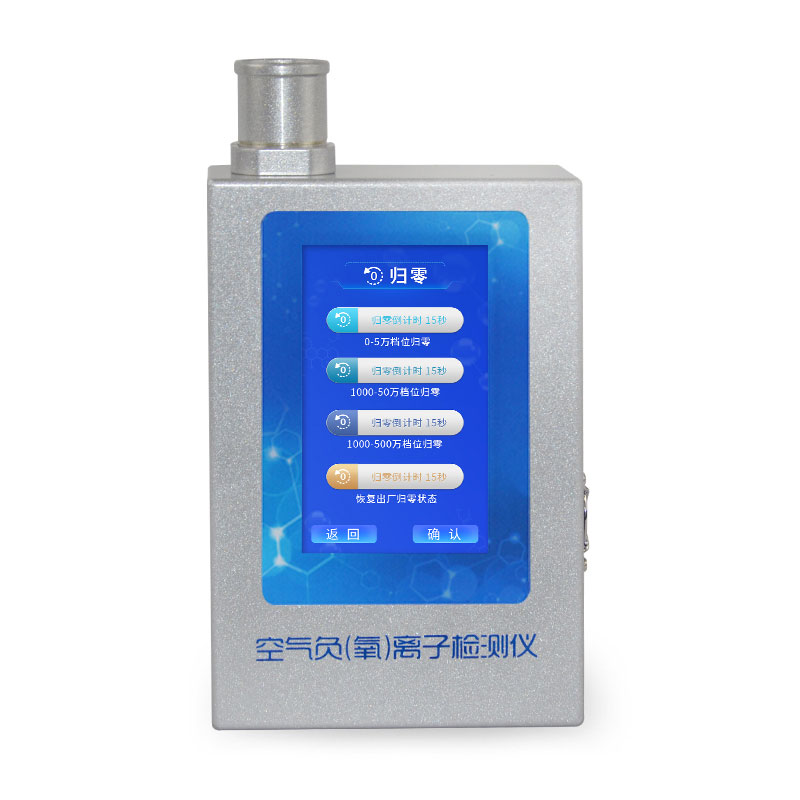Tianqiong Sensor IOT Technology Co., Ltd
Sales Manager:Ms. Emily Wang
Cel,Whatsapp,Wechat:+86 15898932201
Email:info@fengtutec.com
Add:No. 155 Optoelectronic Industry Accelerator, Gaoxin District, Weifang, Shandong, China

Sales Manager:Ms. Emily Wang
Cel,Whatsapp,Wechat:+86 15898932201
Email:info@fengtutec.com
Add:No. 155 Optoelectronic Industry Accelerator, Gaoxin District, Weifang, Shandong, China

Model:FT-FY2
Brand:tianqiong
Negative ion tester
Negative ion tester is a device that measures the concentration of negative ions in the air,It measures, monitors and optimizes air quality by detecting negative air ions.
Features: Mobile measurement | Instant measurement | Intuitive reading | Simple operation | Ultra-long standby
Negative ion tester product introduction:
Negative ion tester is a high-precision, professional air negative ion and formaldehyde detection and analysis instrument.The negative (oxygen) ion capture mechanism of the advanced cylindrical capacitance structure is used to capture the negative (oxygen) ions contained in the atmosphere, and then accurately calculate the statistics through unique algorithms.It has the advantages of stable measurement process, rapid response and accurate measurement results.It also has strong anti-electromagnetic, electrostatic and electromagnetic wave interference capabilities, excellent sensitivity and capture ability to small-particle negative ions, and has excellent overall performance.
Negative ion tester is simple to operate, with a 5.0-inch full-color large screen displaying real-time measurement data, instrument working status, and automatic calculation of average values.Operators can measure quickly without professional training without requiring professional training.
Negative ion tester product application:
Real-time measurement of the atmospheric negative oxygen ion concentration and formaldehyde concentration in the air is the preferred tool for environmental monitoring, nanocoatings, negative ion health products, negative ion home decoration and building materials, indoor detection, air treatment, air purifiers and their products to measure and demonstrate negative ion concentrations.
How Negative ion tester works:
The "capacitor suction method" principle is used to detect negative ions and measure the negative ion concentration value in the air.A quantitative polarization voltage is loaded on the polarization plate (or bias plate) of the ion sensor (or collection barrel or collection barrel), and then the measured air passes through the sensor at a constant speed at the set speed.A specific small particle size negative ions in the air are deflected under the action of an electric field and are captured by the acquisition plate.The negative charge amount of the collected negative ions can be calculated by processing by the collector.
Negative ion tester Advantages and features:
1.Screen display: 5.0-inch capacitive touch screen, 800*480 high resolution, displaying negative (oxygen) ion measurement results in real time;
2.Precision measurement: The internationally advanced cylindrical capacitive suction method is used as the measurement method;
3.Small size: compact internal structure and exquisite appearance, can adapt to various environmental detection, making it easy to use;
4.Ultra-long standby: Built-in large-capacity lithium battery (12V 3000mAh), not subject to power supply and site restrictions, and can be tested immediately;
5.Responsive: The data refresh frequency reaches 1 second/time;
6.Simple operation: The instrument is simple and direct, and the full-color large font display is clear and clear;
Negative ion tester technical parameters:
Negative ion concentration:
Measurement functions: manual measurement, automatic measurement;
Measurement method: negative (oxygen) ion capture mechanism of cylindrical capacitance structure;
Range range: 00,000 to 50,000, 10-500,000, 10-5 million tiers;
Measurement accuracy: ±5%
Resolution: 1/cm3
Mobility: 0.4~1.0 (cm2/V*sec)
Measurement interval: 1 second/time
Measurement mode: continuous
Communication interface: USB
Working environment: Temperature: 0~60℃; Humidity: 0~85%RH
Power supply: DC12V 1A adapter
Built-in battery: battery power supply time ≥8 hours
Average power consumption: ≤2W
Dimensions: 200mm*132mm*58mm
Body weight: 1kg
Housing material: Metal
Formaldehyde parameters:
Display data units: ppm and mg/m³;
Range: 0-5ppm;
Resolution: 0.01ppm;
Preheating time: less than 3 minutes;
Response time: less than 60 seconds;
Recovery time: less than 60 seconds;
Working temperature: -20℃~50℃;
Working humidity: 15%RH~90%RH (no condensation);
Storage temperature: 0℃~25℃;
Service life: 5 years (18℃-25℃ in the air)
Installation bracket: tripod (optional)
Accessories: adapter, cleaning brush, USB data cable, special protective suitcase
Wheat seedling conditions are usually classified into strong seedlings, robust seedlings (including first - class and second - class seedlings), and weak seedlings (third - class seedlings). For different seedling conditions, differential management measures need to be taken during key growth stages...
The weather stations used in the agricultural field are called Agricultural Weather Stations. In order to better serve agricultural production, in addition to the conventional meteorological elements, Agricultural Weather Stations will also focus on increasing the monitoring of soil-related elements...
The FT-WQX6 micro weather sensor is a highly integrated device that combines multiple meteorological parameter measurement functions. Its key feature is the integration of six basic meteorological parameters—ambient temperature, relative humidity, wind speed, wind direction, atmospheric pressure, a...
In an era where technological waves continue to surge and innovative achievements emerge endlessly, the public's environmental awareness has grown increasingly sophisticated, and their concern for ambient air quality has reached an unprecedented level. In the fast-paced modern life, as the inter...